AUGUST 2025 - I'm saying goodbye to the SVG part of my business. My SVG files and web pages are now in the ARCHIVES part of the site. For now, they'll still be available to purchase and the web pages with the instructions will remain available for a limited time. It's important to know, though, that my intention is for these (both files and web pages) to be removed after 31st December 2025.
IMPORTANT: please ensure that you have everything you need - files and/or instructions printed off - by 31st December 2025 as they will not be available after this date.

August Nature Journal Pages
- Home
- Nature Journaling
- August Nature Journal
Explore my August nature journal drawings and notes from Yorkshire, UK...
Hot summer days exploring nature in August 2024 in an East Yorkshire village. Take a look inside my own personal nature journal to share my nature discoveries.
I hope that my nature journal will inspire you to work in your own journal to connect with nature.

Click 'Play' above to watch me flick through my nature journal pages for the month.
You can take a closer look at all the pages below...

August Nature Journal Pages
I love sharing my pages with you...
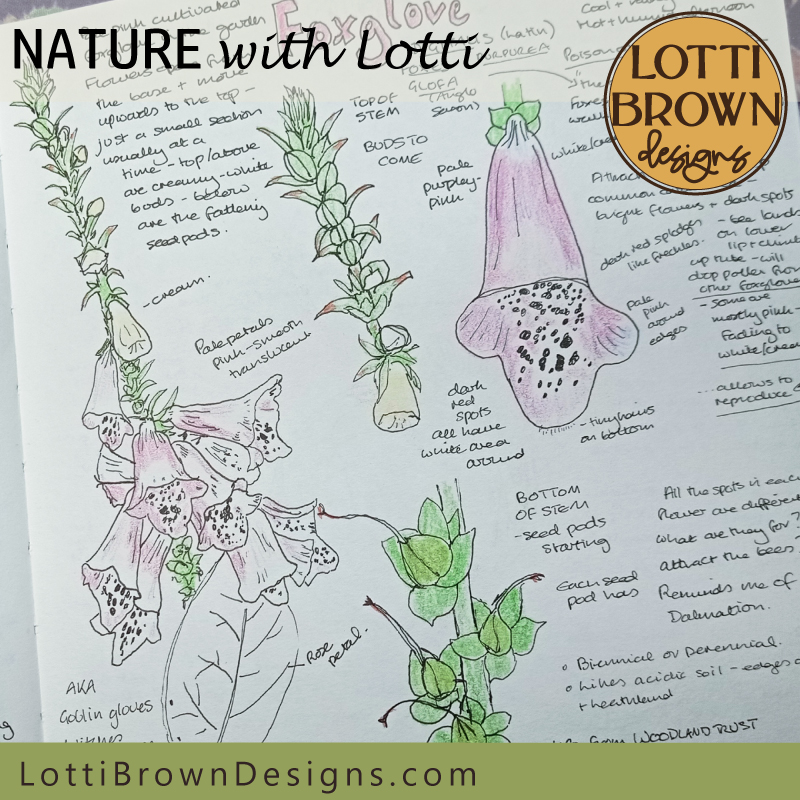 Foxglove nature journal page
Foxglove nature journal pageAugust started cool and rainy but soon heated up. My first nature journal page for the month was for this pretty foxglove which I have in my garden. It was interesting as there were flower buds, flowers and seed pods on the same stem. Named after an Anglo-Saxon word 'Foxes Glofa' meaning glove of a fox and relating to the idea that foxes wore the flowers on their paws to hunt quietly at night!
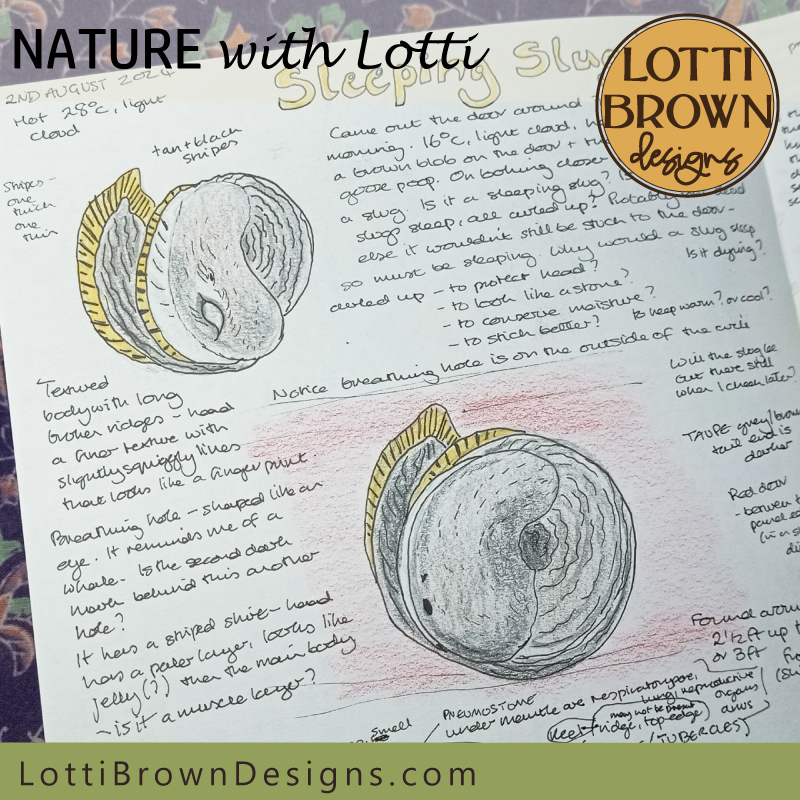 Sleeping slug
Sleeping slugI think the cool mornings (hot afternoons) led to this unexpected find of a curled up sleeping slug, looking decidedly cute and cozy, in the middle of my front door. Of course I was going to journal it! It had disappeared later in the day, leaving just a little slug splodge. Hopefully, he'd slithered off somewhere safe and not been picked off by a hungry bird!
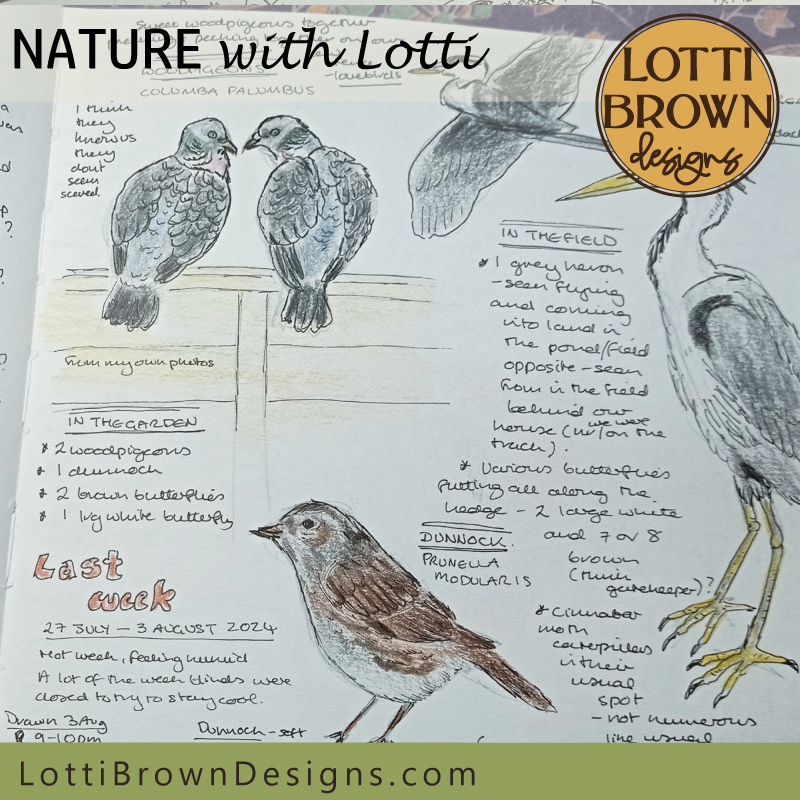 Weekly nature observations - early August 2024
Weekly nature observations - early August 2024I created a nature journal page with my nature sightings from the week before - it had been a hot week so I'd had the curtains closed to stay cool so didn't see much in the garden. But perhaps the wildlife was staying tool somewhere anyway, too? Just our two friendly wood pigeons and a lovely little dunnock who I think maybe lives in our garden. Out in the field, we'd spotted a heron flying over too along with some butterflies plus cinnabar moth caterpillars. I drew these from my own photos and other reference photos.
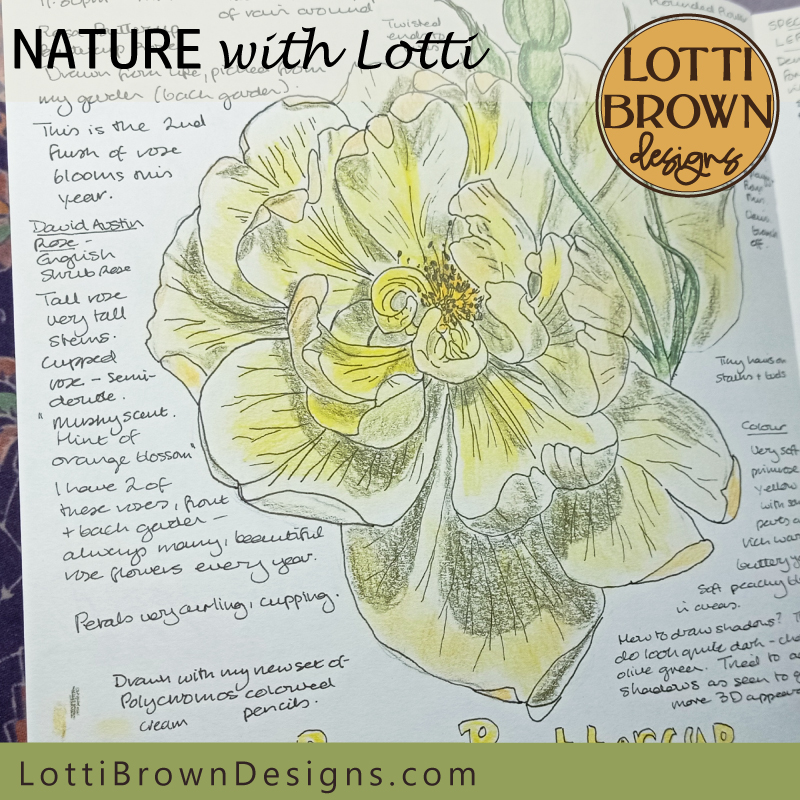 Yellow rose 'Rosa Buttercup'
Yellow rose 'Rosa Buttercup'My 'Rosa Buttercup' in the garden was looking lovely with a second flush of blooms so I thought I'd pick one to draw - I also spotted a very exciting insect on a leaf I was photographing...
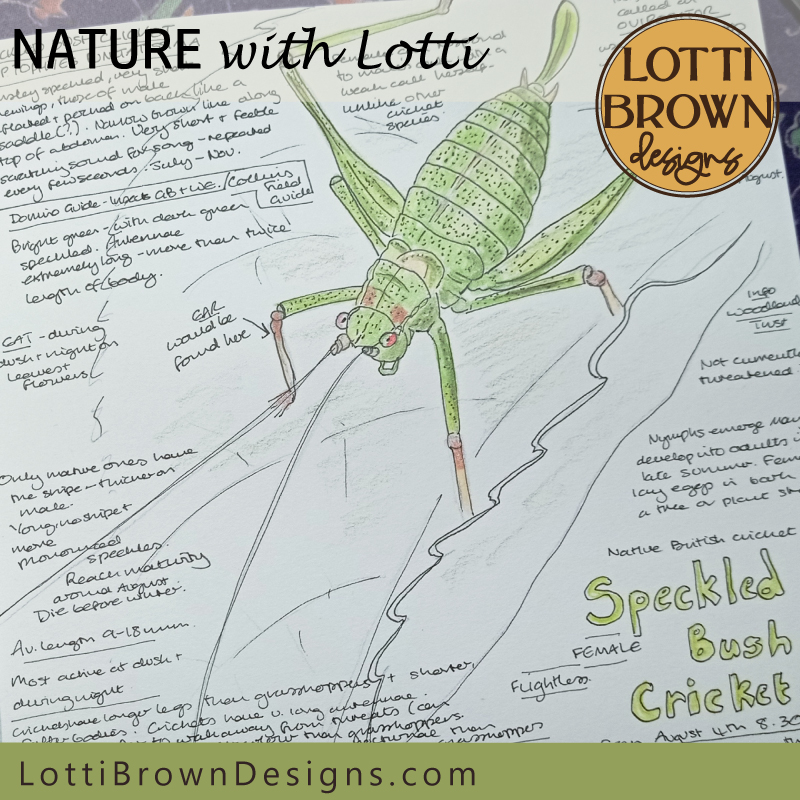 Speckled Bush Cricket
Speckled Bush CricketThis is a Speckled Bush Cricket, I concluded after much recourse to reference books and ID websites - a native British cricket. It has such very short wings (you can see them on her back here) that it can't fly. Her antennae are more than twice the length of her body and she has her ears in her front legs.
The 'tail' on the end that looks like a boat tiller is the 'ovipositor' which is used to place eggs her eggs in suitable places - yes, this one is a female!
For my next nature journal entry, it was back to the 'Rosa Buttercup', specifically the leaves...
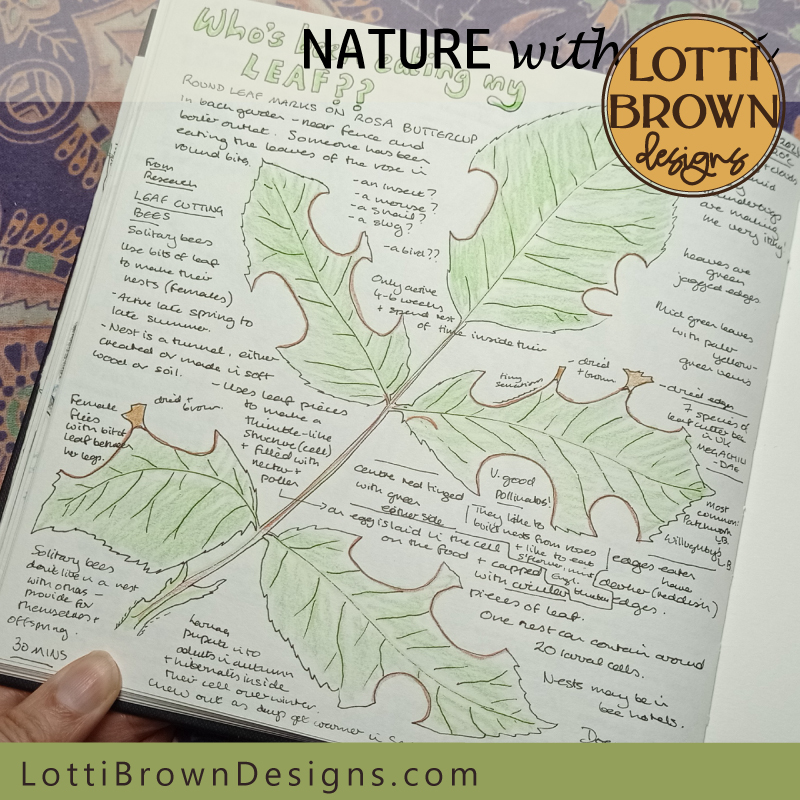 Who's been eating my leaf..?
Who's been eating my leaf..?My rose leaves had these curious round holes been nibbled out of them. What could've made them? It's evidence of a leaf cutter bee, a solitary bee who use pieces of leaf to make a nest of little cells that she fills with nectar and pollen and lays an egg that is then covered with a circular piece of leaf. The following Spring, the little eggs hatch into bees who can feed on the food in their cell before they eat their way out of the leaf covering.
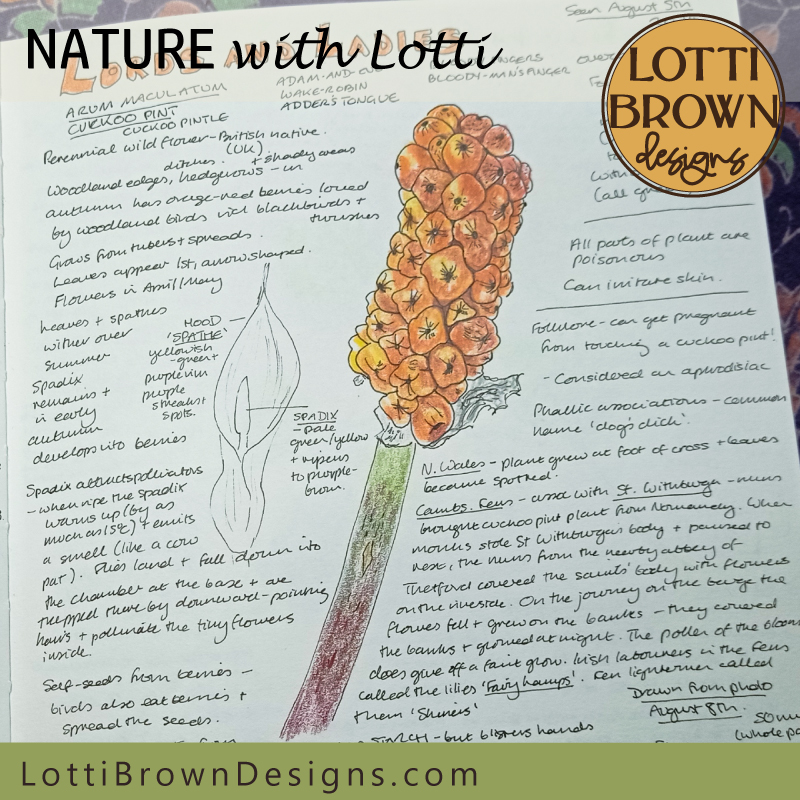 'Lords and Ladies' or 'Cuckoo Pint'
'Lords and Ladies' or 'Cuckoo Pint'I spotted this gorgeous plant in our village garden. It's a 'Cuckoo Pint' which I know by its name of Lords and Ladies. In Spring, there is a hooded lily type flower, but in autumn, the plant develops into this stalk of colourful poisonous berries. There were several stalks of green berries but this lovely orange-red stalk really caught my eye. Other common names it's known by are 'Adam-and-Eve', 'Wake Robin', 'Adder's Tongue', 'Bloody Fingers' and 'Bloody Man's Finger'.
My next journal entry was another nature curiosity...
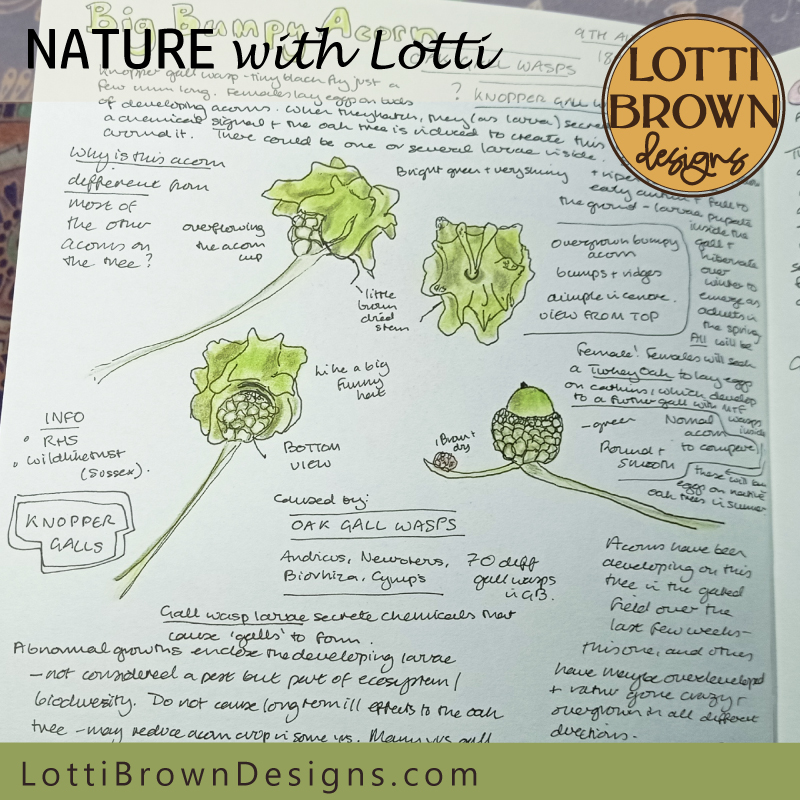 What was causing this acorn to be so big and bumpy..?
What was causing this acorn to be so big and bumpy..?This was an unusual big bumpy acorn that I spotted several of on a tree I regularly walk past. I've drawn one of the normal acorns for comparison. After some research, I discovered it was an oak gall, called a 'Knopper Gall'. It's caused by the larvae of the Knopper Gall Wasp, a type of oak gall wasp who lays its eggs on the developing acorn bud.
As the larvae hatch it transmits chemical to the tree which grows this bumpy growth around the larva to protect it. The larvae pupate inside the gall as it falls to the ground and emerge as female adult wasps in Spring. The wasps have a second life stage and lay eggs on the catkins of the Turkey Oak. When these hatch, they'll be male and female wasps, who'll go on to lay their eggs on the developing acorns again.
Such interesting things to discover through nature journaling!
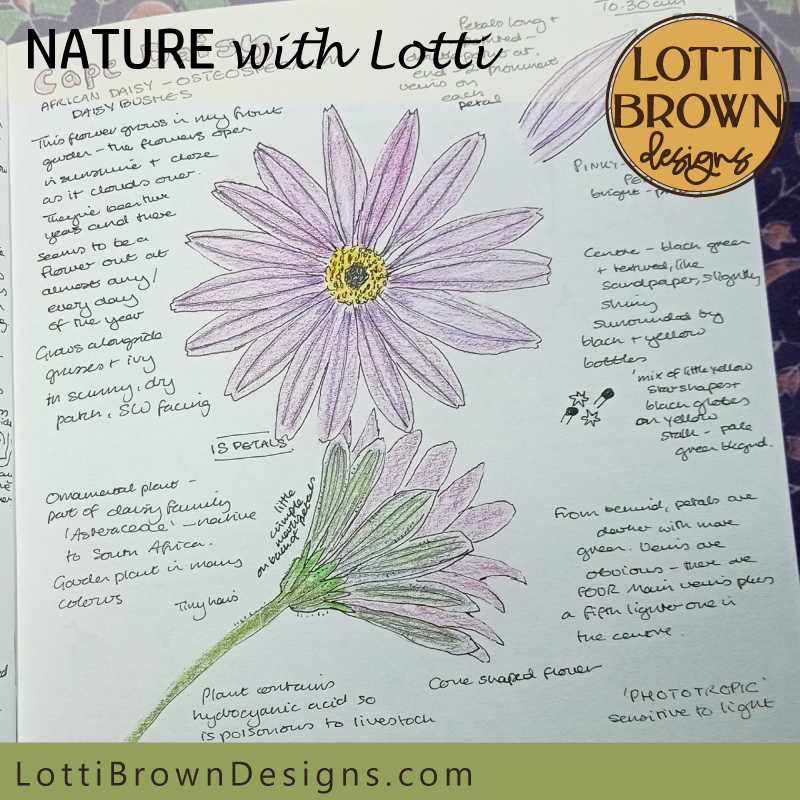 Cape Daisy/Osteospermum
Cape Daisy/OsteospermumMy next thing to nature journal is this pretty Cape Daisy or Osteospermum which grows in my front garden happily all year round and has done for years! I focused on the veins and petals and it was interesting to see the different colour that the petals look from behind. This flower closes up every evening as dusk falls, and also does not open on cloudy days!
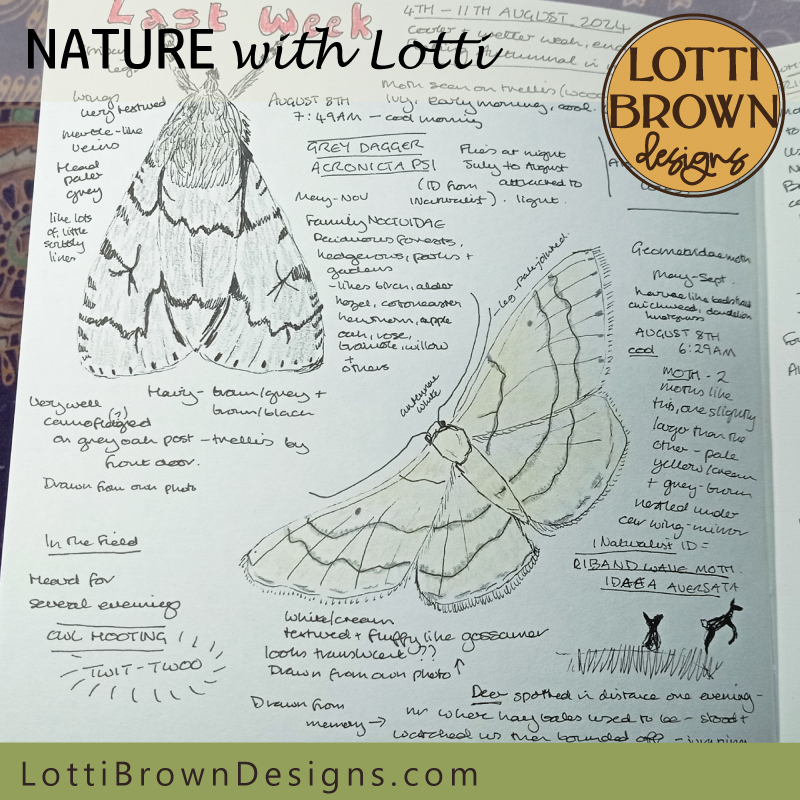 A week of moths!
A week of moths!A cooler and wetter week ended with mainly moth sightings in the garden - two lovely Riband Wave moths nestled under my car wing mirror early one morning were a great opportunity for a photo and a closer look. I also spotted a camouflaged Grey Dagger moth against the grey wood of my trellis arch.
During the week, I'd only spotted our ever-faithful wood pigeons in the garden, but we'd seen a deer (at quite a distance) on an evening walk in the fields, and several times heard an owl hooting.
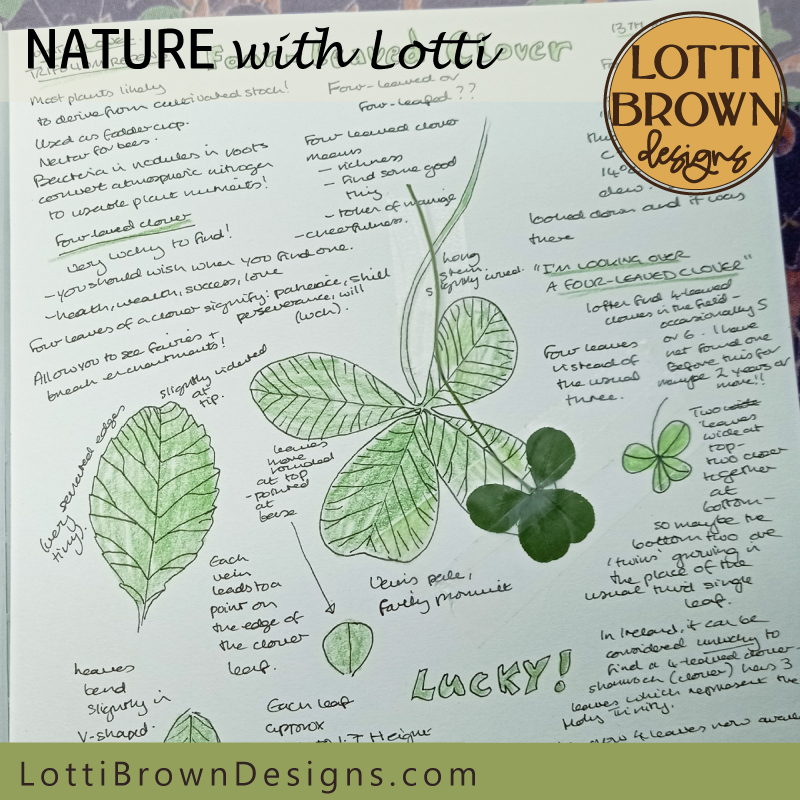 Lucky? A four-leaved clover find!
Lucky? A four-leaved clover find!I had a spot of luck the following morning when I spotted this four-leaved clover on the grassy path as we were walking the dog. I stuck it in my journal to make it lucky (fingers crossed as well!) and did some drawings taking a closer look at the pattern of the veins on the leaves.
I discovered that you should make a wish when you find a four-leaved clover. It may bring health, wealth, success, love and cheerfulness and can allow you to find 'some good thing'! It might also permit me to see fairies and break enchantments. I'll keep you posted!
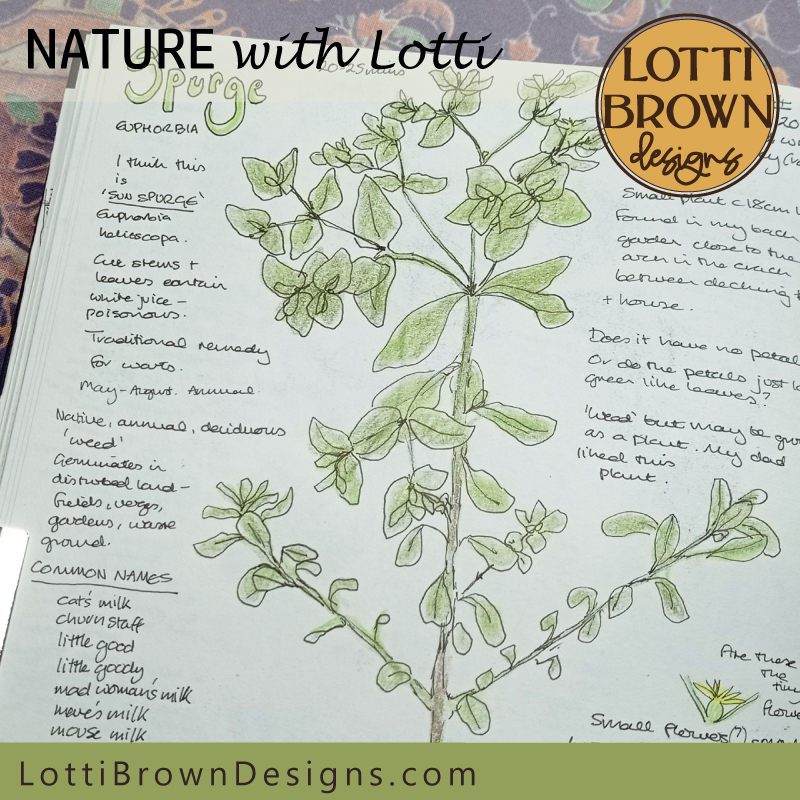 Euphorbia or 'Sun Spurge'
Euphorbia or 'Sun Spurge'I decided to draw this small Spurge growing as a (semi-welcome) weed in my back garden. This is quite a pretty plant and can be considered a weed or garden plant. I think mine is a 'Sun Spurge'. Spurge was a traditional remedy for warts (it has a white juice inside the stems and leaves) and some of its traditional names (wart grass or wartwort) reflected this.
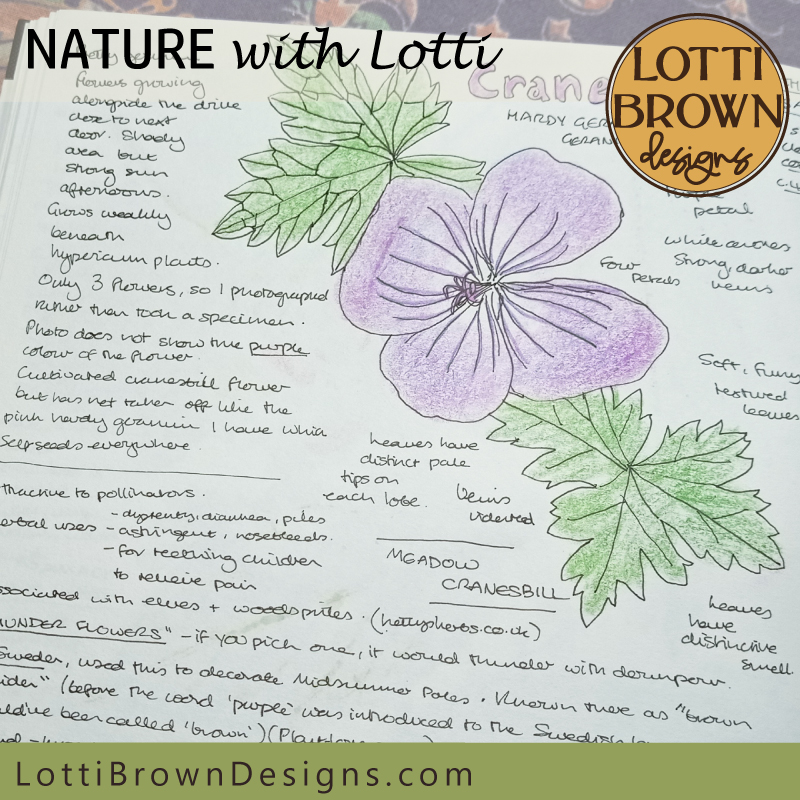 Hardy Geranium or 'Cranesbill'
Hardy Geranium or 'Cranesbill'The Cranesbill (or Hardy Geranium) is another flower sometimes considered a cultivated garden plant and sometimes considered a wild flower or weed. Mine is a garden plant. The flower is sometimes known as a 'Thunder Flower' and if you picked one, it would thunder and rain. I took care to photograph this and not to pick it, just in case!
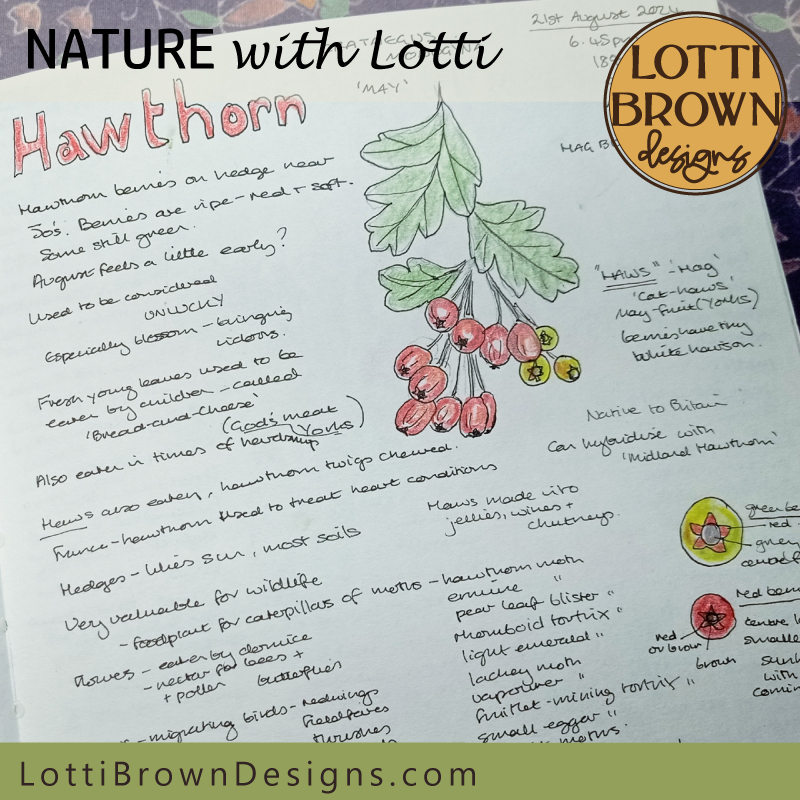 Hawthorn berries in late August
Hawthorn berries in late AugustAs we get towards the end of August, there are signs of Autumn around. The hawthorn hedges are now filled with red berries which are essential for the birds over winter. Haws (the berries) can also be made into jellies, chutneys, and wines. The leaves of the tree were also once eaten, called 'Bread-and-Cheese'.
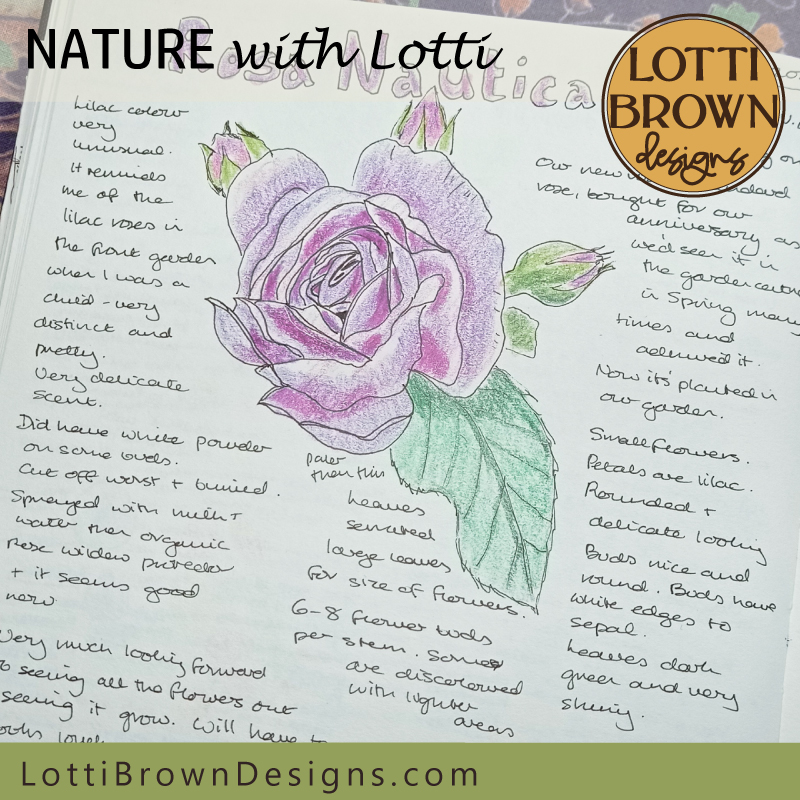 Rosa Nautica
Rosa NauticaAs Autumn approaches, I try to record our remaining flowers in the garden before the dark winter months set in. This pretty lilac rose, Rosa Nautica, is having a second flush of pretty little flowers. New to use, we're enjoying having it in the garden to brighten up an empty spot. Roses are always challenging to draw, so I practiced drawing the unfurling petals with this nature journal entry.
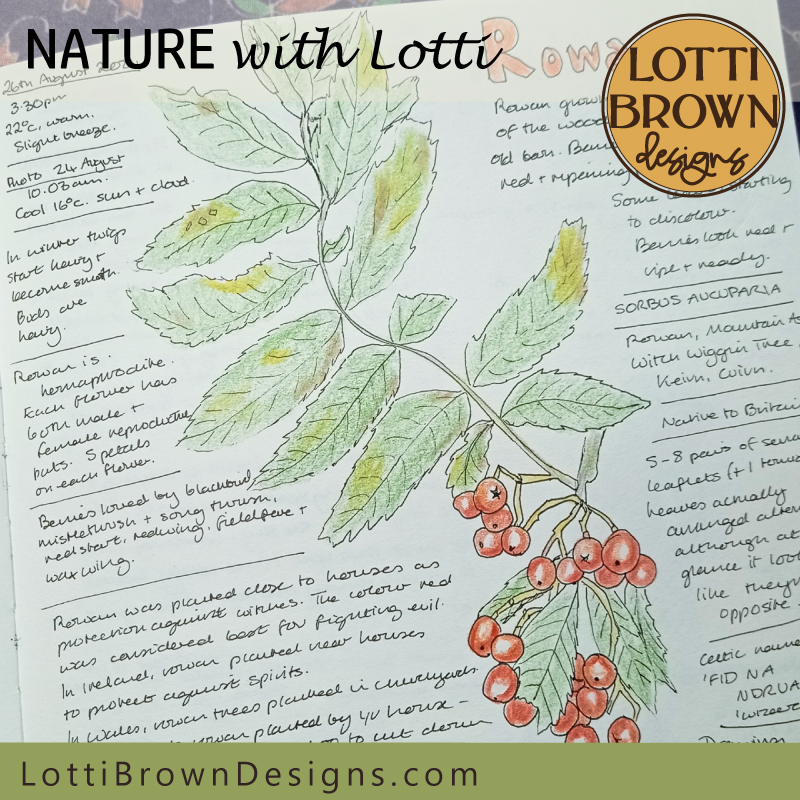 August Rowan berries
August Rowan berriesThe Rowan berries started turning orange back in July, I think, but now they're red and fully ripe. One of my favourite trees, so very pretty and considered a lucky tree to have planted by your house on account of its protection from witches and witchcraft. This tree is one I pass regularly on my walks.
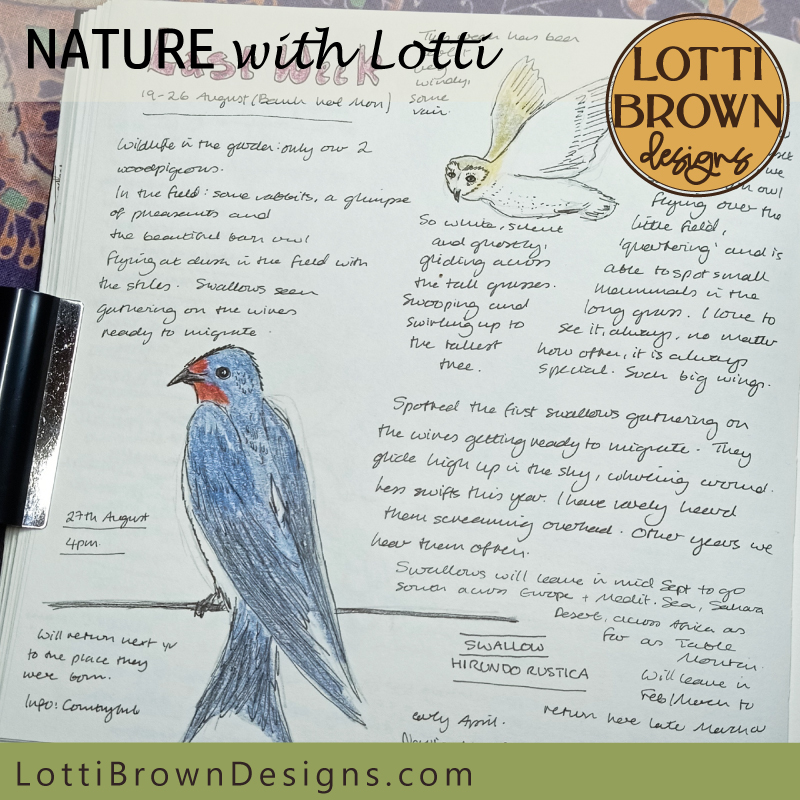 Nature sightings for the week including a barn owl and swallows
Nature sightings for the week including a barn owl and swallowsA record of the previous week's wildlife sightings (19th-26th August) - as the nights are drawing in now, we sometimes see a barn owl at dusk, gliding across a grassy field. Always a special sight! And in another sign of the approaching Autumn, the first sign of a few swallows gathering on the telephone wires, getting ready for their long migration to Africa, leaving us to our cold dark winter, to take up the 6,000 mile journey to return to us again in Spring.
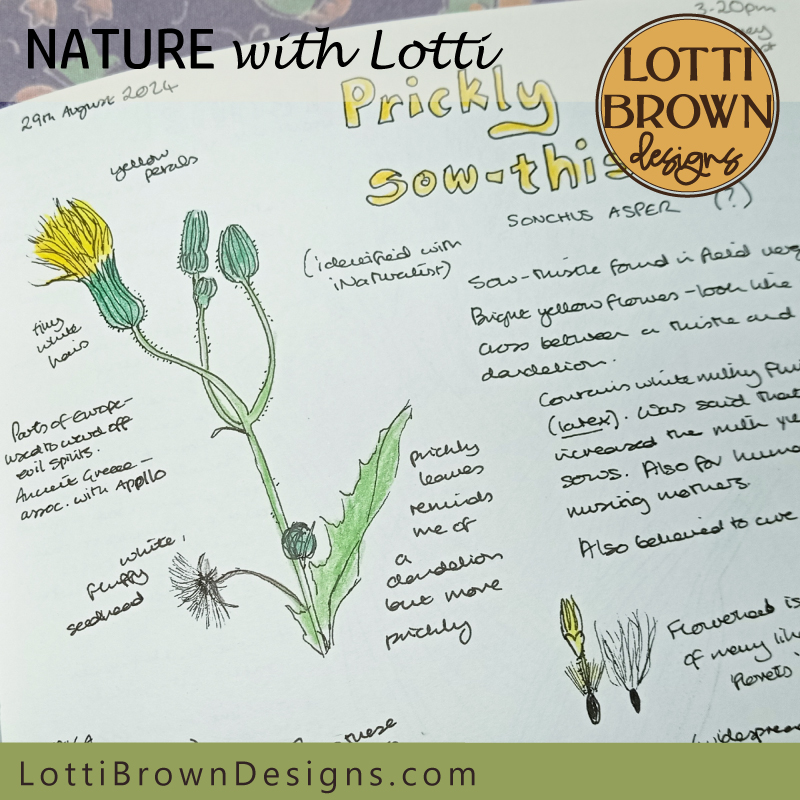 Prickly Sow Thistle
Prickly Sow ThistleA flash of yellow just caught my eye and it was this wildflower/weed that has always just been a random weed to me. I took a photo and used iNaturalist and one of my wildflower books to identify it as a Prickly Sow Thistle - and now it's great to be able to go out in the fields and recognize it as I walk past.
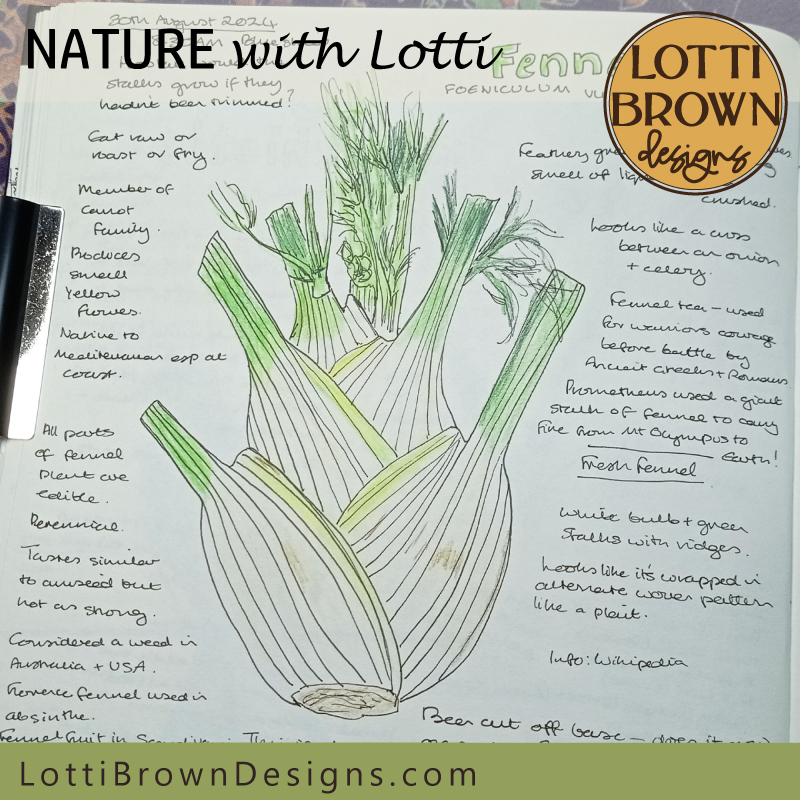 Fennel out of my fridge
Fennel out of my fridgeMy final entry for August is actually from my fridge - this lovely fennel which smelled so fresh and lovely of liquorice that I just had to draw it. The fennel 'bulb' is actually the swollen base of the stem. I ate it for my tea (after drawing) and it tasted delicious!
I hope my August nature journal pages have inspired you with your own nature journal.
Our nature journals don't need to be perfect - their primary function is for us to enjoy relaxing, de-stressing and connecting with nature.
Over the month of August, while we still have plenty of flowers, I've noticed signs of Autumn creeping in, particularly towards the end of the month - so in September I'm expecting quite an Autumnal feel with berries, maybe nuts, seedheads, too...
Do come back and join me for that, too!
You can find out more about nature journaling on my main nature journaling page here...
If you're interested in nature journaling, you might like my 'Imperfect Nature Journaling' online course which is a series of exercises to help you feel connected with nature while nature journaling and explore different ideas and techniques in your nature journal to help you find the right style of journaling for you. You can find out all about my 'Imperfect Nature Journaling' course just below...
Online Nature Journaling Course

If you'd like to explore nature journaling more, please consider joining me for my 'Imperfect Nature Journaling' online course - I've called it this to remind us to nature journal for the process of connecting with nature to feel good and not to put pressure on ourselves to create pretty pages which can quickly ruin the fun and the benefits...
It's a series of 20 lessons which are great exercises that you can do in your own nature journal to help you try out different ideas and techniques.
This will help you get the most out of your nature journaling sessions and understand what style of nature journaling is the best for you personally.
If this sounds like something you might like, you can find out more about the course here...
Want to keep in touch?
Sign up below for my free email newsletter...
My newsletter is usually sent out once a month (at the end of one month or the start of the following month) and you can unsubscribe any time...
Sign up below...!
Recent Articles
-
September Birds in my Nature Journal
Sep 30, 25 04:18 AM
The turning of the year - September birds from my nature journal - owls, greenfinches and migrating geese... -
Meaning and Symbolism of Ivy in the Celtic Tree Calendar
Sep 29, 25 05:10 AM
Explore the meaning and symbolism of ivy as part of the Celtic Tree Calendar... -
Boho Floral Fabrics
Sep 10, 25 06:04 AM
Unique boho floral fabric with a 70s hippy feel - created by artist and designer Lotti Brown
Follow me:
Share this page:




